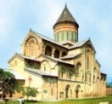
Click on image to enlarge.
|
 GEORGIA
South of the main ridge of the Caucasus, between
the Caspian and Black seas, is an area of mountains and plateaus called Georgia. It has an
area of 26,900 square miles (69,670 square kilometers). Georgia is bounded on the north by
Russia, on the east and southeast by Azerbaijan, on the south by Armenia, on the southwest
by Turkey, and on the west by the Black Sea. Until 1991 Georgia was part of the Soviet
Union. Tbilisi is the nation's capital.
Most of Georgia is mountainous. It has many peaks higher than 4,500 meters. The lower
western slopes and plateaus have a subtropical climate of the Mediterranean type. Citrus
orchards, tung trees for oil, vineyards, tea plantations, and tobacco fields grow here.
East of the mountainous divide between the Black and Caspian seas, a section of drier land
is irrigated to grow cotton, rice, wheat, and barley.
Georgia has a well-developed industrial base, together with its diversified and mechanized
agriculture. The republic has some of the world's major manganese reserves. Other deposits
include iron ore, arsenic, marble, molybdenum, tungsten, mercury, and gold. There are also
fine clays for ceramics, and there is some coal for fuel. The chief manufacturing centers
are Tbilisi, Kutaisi, and Batumi.
The wide array of industrial products includes railway locomotives, heavy motor vehicles,
earth-moving equipment, tea-gathering machines, lathes, and precision instruments. The
chemical industry produces mineral fertilizers, synthetic fibers, and medicines. Georgia
is also famous for its production of commercially sold wines, and it cures tobacco and tea
and produces canned goods. Cotton, wool, and silk fabrics are also manufactured.
HISTORY
The origins of human society in Georgia
can be traced to prehistoric times. The Caucasus was regarded by ancient peoples as the
home of metallurgy. By 65 BC the region was part of the Roman Empire. Georgia was converted to Christianity
in AD 337, and
for the next three centuries it was involved in conflicts between the Byzantine and
Persian empires. After 654 local authority was exercised by Arab caliphs, who established
an emirate at Tbilisi.
During the centuries of close association with the Byzantine Empire, the church grew in
strength until it became independent as the Georgian Orthodox church. The church was a
leading influence in creating a rich cultural heritage, including works of literature,
architecture, and painting. Georgian architecture, in turn, played a large role in
developing the Byzantine style.
Invasions by the Mongols from 1220 onward, coupled with the destruction caused by Timur
Lenk's hordes between 1386 and 1403, ruined the cultural and economic life of Georgia for
centuries. The fall of the Byzantine Empire in 1453 and successive invasions by Turks and
Persians further depressed the area. Between 1801 and 1864 Georgia was gradually annexed
by Russia. In the second half of the 19th century, traditional ways declined, Western
influences grew, education spread, and industrialization began.
In 1918 the Georgians set up an independent republic and put themselves under German
protection. Early in 1921 the Soviet Army invaded Georgia, and a Soviet regime was
installed in Tbilisi. Georgia was incorporated into the Transcaucasian Soviet Federated
Socialist Republic. On Dec. 5, 1936, the Transcaucasian republic was dissolved and the
Georgian Soviet Socialist Republic was established. Georgia became independent republic
after the collapse of the Soviet Union in December 1991. Population (1991 estimate),
5,464,200.
TBILISI
The capital of the Georgian Soviet Socialist
Republic since 1921, Tbilisi became the capital of the independent republic of Georgia
following the collapse of the Soviet Union in December 1991.
The city stretches for about 19 miles (30 kilometers) along the Kura River, where it
separates the Trialeti and Kartli mountain ranges. The city is one of the principal
industrial centers of Eastern Europe. Electric locomotives, machine tools, agricultural
machinery, and electrical equipment are among the products manufactured here. Other
industries include textiles, leather goods and footwear, furniture, glass and porcelain,
pharmaceuticals, bricks, and wood products. Foods, beer, wines, liquors, and nonalcoholic
beverages are produced.
Tbilisi is a major cultural and educational center for Georgia. It has a university, ten
other institutions of higher education, more than 100 research establishments, and the
Academy of Sciences of Georgia. There is an Academy of Arts; several theaters for drama,
ballet, and opera; a state library; a botanical garden; a film studio; a philharmonic
society; and more than 100 libraries. Located in the Old City are ruins and buildings from
former centuries, including a 6th-century church and the Narikala citadel.
According to tradition, King Vakhtang Gorgaslan moved his capital in 458 to Tbilisi, which
had health-giving hot springs on the site (tbili means "warm"). Over the
centuries the city was frequently captured and sacked. Before Arabs conquered it in the
7th century, it had been dominated by Persians and the Byzantine Empire. In 1234 it fell
to the Mongols, and in 1386 it was attacked by Timur Lenk, also known as Tamerlane.
Finally, in 1801, it was captured by the Russians and became part of their empire until
1991. Population (1989 estimate), 1,260,000. |






